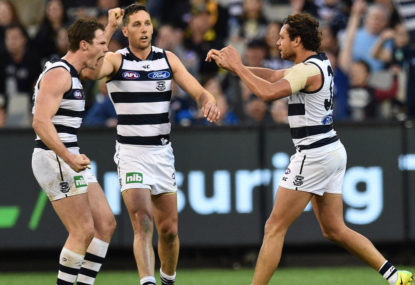We’re back talking about ‘the game’ again. That tired, worn out cliché has one again been thrust upon us, with the veil of a successful debut round of AFLW cloaking some sinister works in virtual secrecy.
Over the weekend, the AFL world grew a little with the first round of the AFL Women’s League. Crowds flocked, gates were shut, football was played. It felt like Australian rules was back for another year – the stories of tracks being burned and houses falling down seemingly on their own took a back seat.
Last week was a momentous one for Australian rules football. But if you weren’t looking closely, you missed a significant shift in AFL House policy making.
A piece published by Fairfax media last Thursday was titled ‘AFL’s secret trials have the potential to revolutionise the game‘. In it, it was revealed AFL HQ had used practise matches by two AFL sides – Sydney and Geelong – to trial a 16-a-side version of the game.
It followed up a piece published on Tuesday, which confirmed St Kilda had also been used as a guinea pig but to trial zones at stoppages. The zones were enforced at stoppages, with at least two players from each team required to be goal side of each 50-metre arc before the ball was put back into play.
Prima facie, there is nothing wrong with this. The AFL would be negligent if it was sitting pat and not trying new things.
However, these were very deliberate stories – let’s not call them plants – pushed by AFL House. We know this because the executive team was wheeled out to provide quotes, designed to show us all that these trials are serious and we should all brace ourselves for change. It’s the same playbook that resulted in the abolition of the third man up for 2016.
The key reason cited for the introduction of the Marc Blicavs rule was was that it “was having no effect on improving congestion”. Never mind the statistics that the AFL rolled out showed it was a very effective tactic for teams who used it at ball ups to generate a clearance.
(I’m still salty about this one)
But I digress. Since when does everything have to be about reducing congestion?

There has been plenty of talk in recent years about congestion and the impact it was having on “the game”. It seemed to crest in the middle of 2015, where so many takes were flying I felt compelled to pretend I was a graphics designer for a day to come up with ‘The Expanded Goalsquare’ fix.
It was a crazy time, but a fleeting one, with Hawthorn and West Coast – two teams who were able to rise above the congestion which pervaded the mediocre sides with precision kicking and well-crafted game plans – facing off in the grand final.
We made it through the entire 2016 without any material talk of congestion, or “the game”, too. Where did it go? Perhaps the Bulldogs, who took to high volumes at the contest like a pig in mud, killed off the notion that congestion was uniformly a bad thing. Perhaps it was the general quickening of the pace of play, which meant more patches of wide open running to help balance the slog.
Maybe it was the 120-minute death match we know as the second preliminary final. It’s difficult to say.
Make no mistake folks, it’s back. Congestion is out to get us. We’ll all be congested. The game is in jeopardy. It’s time for drastic action.
Those aren’t my words. Those are the (liberally paraphrased) words of those who are charged with the long-term health and prosperity of Australian rules football. This line, roughly four paragraphs into Thursday’s revelatory article, sent the closest thing to chills a game designed to entertain and distract can send down my spine.
The laws of the game committee has concluded that there are two practical ways to reduce congestion: starting positions (zones) and reducing the number of players on the field.
Let’s break that sentence down, piece by piece.
The laws of the game committee…
You mean that unrepresentative standing committee that exists solely to tinker and toy with the fundamental foundations of a game which had existed for near-enough to 100 years before its existence without collapsing into a farcical pit of despair for which you now seem intent on both creating and then dragging it into?
The committee that had become so influential that AFL House felt compelled to draft a set of guidelines designed to put a hard limit on the committee’s madness? The guys that just recommended the abolition of a tactic that almost no one thought was a problem and almost no one was aching to get rid of? Oh yes. Those guys. Go on.
has concluded…
Fantastic. A conclusion has been reached. You haven’t even articulated the problem.
that there are two practical ways…
Let’s rule everything out except for the two things for which we have decided will be subject to trials.
to reduce congestion
Congestion! There it is sports fans. The pretext for every rule change under the sun. More congestion: bad. Less congestion: good. How much is the right amount of congestion? Who knows! It doesn’t matter though because we’ve already concluded that there exists on this earth two practical ways to reduce it.
Starting positions (zones) and reducing the number of players on the field
So that’s a hard no to The Expanded Goalsquare. Duly noted. At least that dastardly last touch rule has been given the Old Yeller treatment.
I have a third way for you guys. Leave it be.
Have your trials, throw science at the wall and see what sticks. But this talk of congestion is rapidly spinning out of control. It is the pretext for something else altogether, except I can’t work out what something else is.
Perhaps it’s all aimed at improving scoring, with congestion being the limiting factor behind the dip in league-wide scoring to below 90 points per game in recent years. That’s fine, but I suspect the 88 points per game that AFL teams put on the board last season is a very good mark.
Over the weekend, the average AFLW score was 26 points in a bit over an hour of play. That’s somewhat chalk and cheese, but it illustrates just how difficult it is to move a piece of leather from one end of an 180-metre playing field to the other using kicks and handballs. And as we’ve demonstrated previously, the best sides still have no trouble scoring well into three figures.
Perhaps it’s a pining for the good old days of 100-goal key forwards? Of one on ones across the ground and guys playing with two torn ACLs? I’ve got news for you, AFL House: those days aren’t coming back.

(As an aside, I had a chuckle to myself the other night when watching some of Fox Footy’s classic games. Saverio Rocca took a leading mark and Drew Morphett let the audience know that he’d been in and out of the team on account of a rocky year prior. Rocca had kicked 59 goals in said rocky year)
Even if it was possible, your two anointed practical ways aren’t doing squat.
Can you imagine Gold Coast’s Tom Lynch and GWS’ Phil Davis having to run back and forth from their position in a press zone and the 50-metre arc during a phase of play with a few repeat stoppages? Don’t tell me the coaches will abandon the press just because it might hold the game up for 20 seconds or so at each stoppage.
Don’t tell me the coaches won’t instruct their key forwards and backs to meander into position so they can set their midfields up how they want. It would be a disaster.
As for 16-a-side, with more open space on the ground, which players do you think are getting cut first? The ruck-forward and the key defender. There goes your hopes of a one-on-one contest inside 50. Indeed, 16-a-side creates even more of an incentive to stack numbers at the ball.
But I’m sure that’s what the trials are saying. And I’m sure we’re getting this thrust upon us anyway. In an ominous sign, last year Mark Evans was quoted extensively in The Guardian in a piece discussing the Laws of the Game Charter. His closing comments?
Evans suggested if the committee was minded, it “opens up the discussion on whether 18 players per team is the right number… or restrictions on movement to try and spread the game out”.
Well how about that. The Guardian piece also refers to a process whereby the Laws of the Game Committee produce research papers for consideration by the AFL executive and AFL Commission, which include evidence and a recommendation or piece of advice. I have never seen one of these papers. Perhaps they should be available for all to see, particularly when such fundamental changes to the rules are being touted.
For the sake of the game – damn it now I’m talking about “the game” too – AFL House must make their process around rule-making more transparent. AFL House must take the pulse of the fans, the players, the coaches, the administrator and the Laws of the Game Committee when considering fundamental changes to the way Australian rules football is to be played.
Mark Evans, who appears to be the administrative sponsor of this program, cannot be allowed to continue to push this agenda without more transparency.
AFL House simply must take a year off changing the rules. This is getting too much for a thinking fan to take. We are on the ground floor of the most even era of the AFL in what feels like an eternity. Let’s just leave things be, and see what the 700-odd professional footballers and 200-odd coaches and countless more administrators can do within the bounds of what we already have.
Indeed, the AFL might consider a congestion-busting initiative of its own: get rid of the Laws of the Game Committee, and build something leaner, more open and temporary in nature. That’s a resolution most fans could get behind.































































































